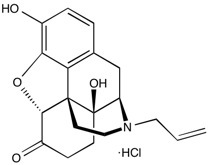Naloxone HCl | Opioid receptor antagonist
NMR (Conforms)

Available Options
| Size : | Price | Quantity | |
|---|---|---|---|
| 100 mg | $50.00 | ||
| 500 mg | $150.00 |
Naloxone (357-08-4) is a pan-opioid receptor antagonist, Ki=3.7, 9.2 and 33 nM for m, k and d opioid receptors respectively.1 In clinical use in opiate abuse and overdose rescue.2 Blocks opiate- promoted wound healing.3 Attenuates the pruritic response to rimonabant in a rat model.4
References/Citations
1) Le Bourdonnec et al., (2008), Novel trans-3,4-dimethyl-4-(3-hydroxyphenyl)piperidines as mu opioid receptor antagonists with improved opioid receptor selectivity profiles: Bioorg. Med. Chem. Lett.. 18 2006
2) Boyer et al. (2012), Management of opioid analgesic overdose; New Engl. J. Med. 367 146
3) Wang et al. (2017), Opioids and opioid receptors orchestrate wound repair; Transl. Res. 185 13
4) Wright and Rodgers (2013), Low dose naloxone attenuates the pruritic but not anorectic response to rimonabant in male rats; Psychopharmacology (Berl.) 226 415
NMR (Conforms)
Safety Data Sheet:
Product Data Sheet:
Materials provided by Focus Biomolecules are for laboratory research use only and are not intended for human or veterinary applications. Please note that we do not sell to individuals and that all orders placed by non-research organizations will incur a $20 restocking/refund fee
Naloxone (357-08-4) is a pan-opioid receptor antagonist, Ki=3.7, 9.2 and 33 nM for m, k and d opioid receptors respectively.1 In clinical use in opiate abuse and overdose rescue.2 Blocks opiate- promoted wound healing.3 Attenuates the pruritic response to rimonabant in a rat model.4
References/Citations
1) Le Bourdonnec et al., (2008), Novel trans-3,4-dimethyl-4-(3-hydroxyphenyl)piperidines as mu opioid receptor antagonists with improved opioid receptor selectivity profiles: Bioorg. Med. Chem. Lett.. 18 2006
2) Boyer et al. (2012), Management of opioid analgesic overdose; New Engl. J. Med. 367 146
3) Wang et al. (2017), Opioids and opioid receptors orchestrate wound repair; Transl. Res. 185 13
4) Wright and Rodgers (2013), Low dose naloxone attenuates the pruritic but not anorectic response to rimonabant in male rats; Psychopharmacology (Berl.) 226 415
Calculate the molar concentration, mass or volume in a solution.
Concentration × Volume × Molecular Weight = Mass
Focus Biomolecules • Plymouth Meeting, PA USA • 1-855-FOCUS21
Focus Biomolecules
Plymouth Meeting, PA USA
1-855-FOCUS21
Website Created by Advanta Advertising LLC.

